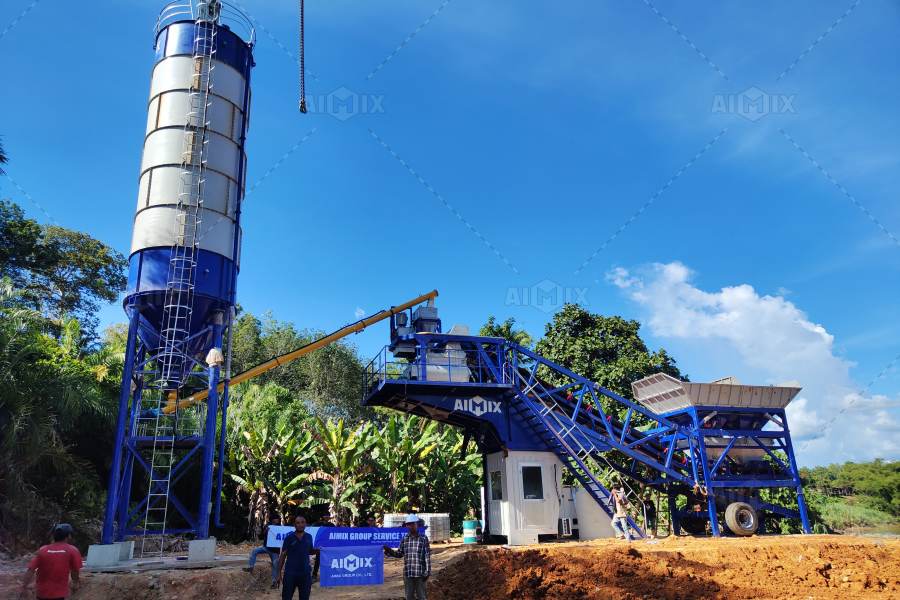In today’s fast-moving construction industry, space, speed, and cost-efficiency are vital. Contractors and developers are increasingly turning to small concrete batching plants for flexible, localized concrete production. But what truly sets these plants apart isn’t just their size—it’s their compact design. More than just a space-saver, compact design contributes directly to operational efficiency, faster installation, reduced waste, and higher ROI.
This article explores how compact design enhances the overall performance and cost-effectiveness of small concrete batching plants across different aspects of production, setup, and management.

One of the most immediate benefits of a compact design is quick installation. A small concrete batching plant with integrated or modular systems requires minimal foundation work. Many models can be assembled and commissioned within a few days—sometimes even within 24 to 48 hours—compared to traditional stationary plants that may take weeks.
This speed is especially beneficial for:
The compact footprint also means less space is needed for installation, which is particularly advantageous in urban projects or small construction sites where land is limited.
The compact configuration of a small concrete batching plant reduces the distance materials must travel between stages of production. In traditional large-scale setups, aggregate, cement, and water often move across longer conveyors or through extensive piping systems, increasing energy use and maintenance needs.
Compact plants, on the other hand, often feature:
This tightly organized structure ensures that materials flow more directly and smoothly from storage to mixing, reducing delays and minimizing the chance of material loss or contamination. The result is a streamlined production process, with each cycle running faster and more predictably.
Because compact batching plants use shorter conveyors, smaller motors, and less equipment overall, they naturally consume less electricity and fuel than larger, more complex setups. This is particularly important for companies looking to cut operating costs or meet energy efficiency targets.
Features like energy-efficient motors, compact control systems, and shorter hydraulic or pneumatic lines contribute to:
For many small and medium-sized contractors, these savings add up quickly—reducing the total cost of ownership without sacrificing output quality.

Smaller and smarter plant designs mean fewer mechanical parts, which directly translates to:
Routine checks like belt alignment, bearing lubrication, and sensor calibration can be performed more quickly and safely due to the plant’s accessible layout. This also reduces the need for highly skilled maintenance personnel or specialized tools.
From an operational standpoint, compact plants usually come with user-friendly control panels, often featuring touch screens, automated alarms, and real-time monitoring. This allows even small crews or new operators to run the plant efficiently, further cutting labor costs and human error.
Transportation of concrete batching equipment can be a significant portion of the upfront cost—especially when dealing with large-scale stationary concrete plants that require multiple trucks, oversized loads, and special handling.
Compact batching plants, by contrast, are:
This not only reduces shipping fees but also lowers the risk of transport damage, improves delivery times, and simplifies logistics planning—especially for international buyers or those working in remote areas.
On busy construction sites, every square meter counts. A compact batching plant can be installed in confined spaces, leaving more room for:
Efficient use of space enhances overall site coordination, reduces safety risks, and increases productivity—especially in congested urban developments or infrastructure projects.
Compact batching plants are not only suitable for general concrete production—they’re also ideal for specialized concrete types, including:
Because of their flexible layout and customizable components (e.g., additives dosing units, moisture sensors), these plants can be tailored to specific job requirements without major design changes or added costs.

The compact design of a small concrete batching plant is more than just a space-saving feature—it is a strategic advantage that enhances every stage of production and operation. From faster setup and reduced energy consumption to streamlined material handling and lower maintenance costs, compact batching plants are redefining what it means to produce concrete efficiently.
Whether you are a small contractor launching your first project or a seasoned builder managing multiple sites, investing in a well-designed, compact small concrete batching plant can deliver superior results, lower total cost, and a stronger competitive edge in today’s construction landscape.